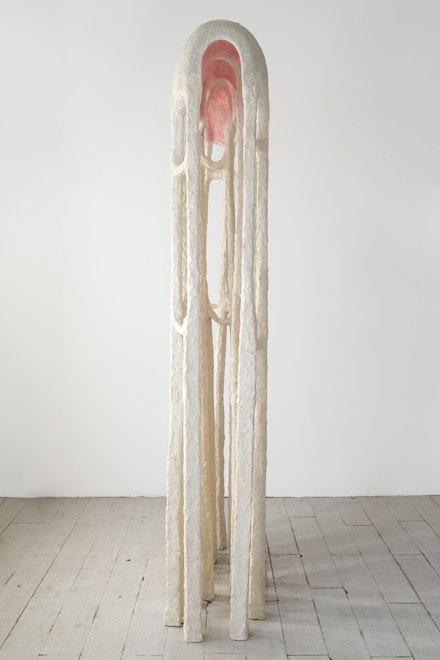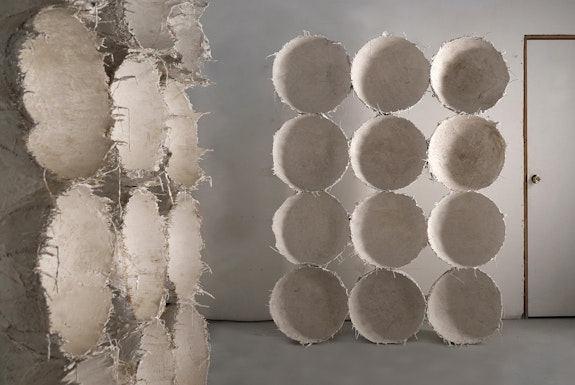ArtSeen
Bronx Calling: The Fifth AIM Biennial

On View
The Bronx MuseumNovember 10, 2021–March 20, 2022
A dark blue paper shopping bag from the Gap lies flat and semi-dissolved on two sheets of cardboard that look eerily like a sidewalk; the defeated bag is dappled with dried leaves. Shopping on a Rainy Day (2015), by Estelle Maisonett, shows traces of human presence, with a lyrical touch that requires no explanation—not even the title is really necessary. Not far from Maisonett’s elegy to city life is Yan Cynthia Chen’s High Palate (2019), a surrealist sculptural intersection of bodily references—an architectural rendering of the roof of one’s mouth—and the notion of that anatomical location as a site of refuge during a young Chinese immigrant’s difficult assimilation process, deeply personal but accessing every viewer’s sense of a “safe place.” Bronx Calling, the fifth iteration of the Artist in the Marketplace (AIM) Biennial at the Bronx Museum, is unique in that it passively presents artists working at their own pace rather than proselytizing a curatorial vision of the contemporary scene. The 68 artists included in this hefty and deep exhibition participated in the 2018 and 2019 AIM programs. They were not chosen by curators Eva Mayhabal Davis and Ian Cofre, but the hands of the curators are clearly present as they worked closely with the artists under less-than-optimal pandemic conditions to clarify each participant’s vision in order to craft a concise yet wide-ranging vision of artists’ practices in New York City.

The curator’s pairing of artists as neighbors within the space also uncovers various synergies of meaning that would not necessarily be apparent from their accompanying statements. Sculptor Trevor King’s Never (2021), a series of 24 rough burlap hemispheres painted white and placed in two grids of 4 × 3 units, melds with Lady K-Fever’s (Kathleena Howie) mixed media installation. The two artists engage in a similar game of repetition and difference, though the former works in a formalist métier while the latter’s store-bought canvases bedecked with strings of pearls, swaths of fabric, and pieces of old clothes (the remains of a relationship) end up being more similar than different despite their multitude of textures—both artists seem to engage with a tragic banality. Mauricio Cortes Ortega’s tall and slender black and white drawings—towers of Grecian or Roman vases in Balance Classroom A, Balance Classroom B, and Balance Classroom C (all 2021)—linger somewhere in between a classical and rococo aesthetic and are not so distant from the series of silhouettes in Katherine Toukhy’s animation Sunken Sunbeats (2019). Both artists utilize the drama of sharp profiles in their work as a means of critiquing colonialism: Ortega referencing Mexico and Toukhy examining its repercussions in Egypt. While it is tempting to approach similarities among the works in a biennial as a harbinger of movements, at times it is simply a serendipitous confluence of two artists’ interests. Cay Yoon’s glistening and seductive offal-shaped ceramic vessels Standoff (2021), Tightass (2021), and But I Tried So Hard (2020) slither and writhe next to EunJung Park’s sensual Blue Migration (2021), a similarly gooey conglomeration of bulbous forms and pearlescent nodules.

Much of the work was produced during the pandemic, and while it is hard to walk through an exhibition of this breadth and attempt to imagine the “what if” non-pandemic counterhistory, very little of it addresses the past two years explicitly. More frequent is a wonderful and blunt candor that one would like to think is New York centric. Vanezza Cruz’s Imaginaciones de la Diáspora: Artefacto Serie #1 / Desde el olvido del mar (2021) channels an Arte Povera feel, resembling a rolled-up hammock simultaneously leaking trash and treasure, the detritus of sand and shells accruing on the gallery floor beneath: it is an ingenious metaphor for history. Reiko Hamano’s Between You and Me and the Ocean (2017-21), a witty and rhapsodic sculpture—three LCD screens displaying seascapes, resting precipitously on two papier-mâché rocks, themselves nestled on a striped cushion—is perhaps emblematic of a newer contemporary hybrid installation trend. Similar in their multimedia assemblage construction to Hamano are Jack Hogan’s lachrymose work assessing the alignment in the lives of flies and cows, and that of Marco Scozzaro and Levani (Levan Mindiashvili) as well: combines of found objects, artist-fabricated objects, and occasional digital interfaces, partially or fully encompassed by geometric structures and/or furniture. Emily Henretta’s work Sisters (2020) is a pair of limp fabric prints pulled from various sources—some silkscreened, others relief printed. The two components are visually connected but carefully separated. In fact, the artist’s statement declares this is a print about longing for her sibling during the pandemic, and it functions as a well-considered metaphor for the past two years and perhaps our current society as a whole: one in which everything is close to hand except what one needs most.

